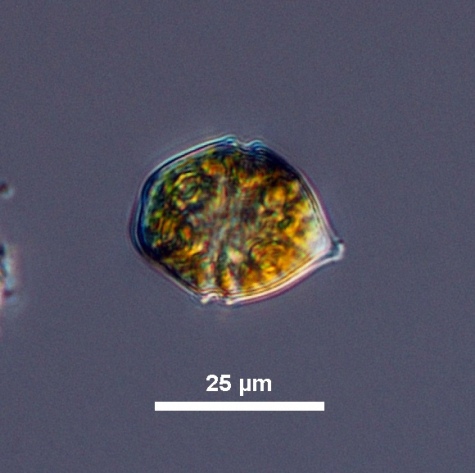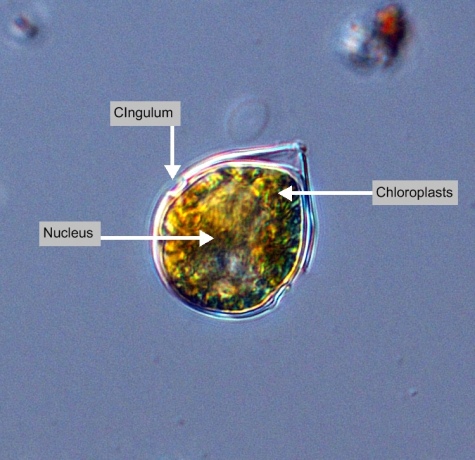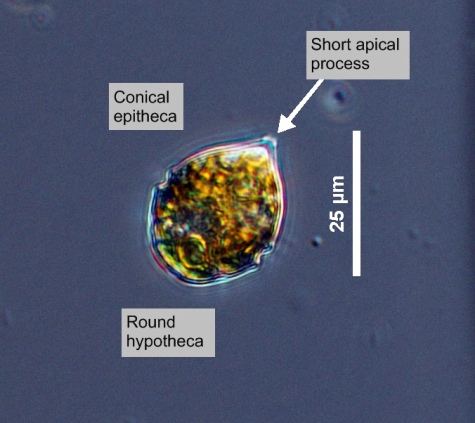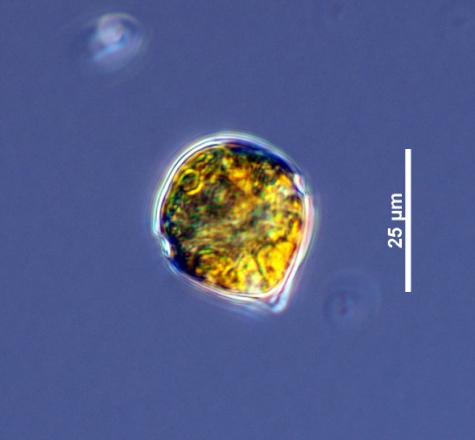



|
Synonym(s)
Glenodinium acuminatum Jorgensen 1899
Periidinium faeroense Paulsen 1905
Peridinium trochoideum (Stein) Lemmermann 1910
Scrippsiella faeoense (Paulsen) Balech and Soares 1967
Scrippsiella faeroense Dickensheets and Cox 1971
(EOL 2011, Horner 2002)
Classification
(Guiry and Guiry 2011)
Lifestyle
Cyst
"A thick-walled dormant cell" (Horner 2002).
cyst producer, which aids in its success in the CloseNeritic
Describing shallow, near-shore areas and the organisms that live there. Refers to shallow marine waters ranging from the low tide mark to the continental shelf. Varying amounts of sunlight penetrate the water, allowing photosynthesis by both phytoplankton and bottom-dwelling organisms. Close proximity to land favours high nutrient content and biological activity (Encyclopedia Britannica 2011).
neritic environment, because cysts act as a CloseBenthic
The ecological zone at the bottom of a body of water.
benthic reservoir of the vegetative population (Wang et al. 2007). Its cysts are spherical and covered with CloseCalcareous
Describing the character (i.e., chalky) or chemical presence of calcium carbonate (CaCO3) as a component of phytoplankton cell covering.
calcareous CloseSpine
In some diatoms, "closed or solid structures projecting from the cell wall;" in dinoflagellates, solid projections that usually taper to a point.
spines (Horner 2002).Description
Epitheca
In thecate dinoflagellates, the anterior part of a dinokont cell above the cingulum. The equivalent of epicone for naked dinoflagellates.
epitheca is conical and has a short CloseApical (axis, spine)
The region of the apex or point. Refers to the most anterior point or region of the cell (HPP 2003).
apical CloseProcess
A natural projection or appendage on an organism.
process. The CloseHypotheca
In thecate dinoflagellates, the posterior part of a dinokont cell above the cingulum. The equivalent of a hypocone for naked dinoflagellates.
hypotheca is round and does not have any projections (Horner 2002).Measurements
Diameter: 20 - 23 μm
Similar species
Harmful effects
Habitat
Distribution
Cosmopolitan
Widely distributed; occurring in many parts in the world.
Cosmopolitan species in coastal temperate waters (Horner 2002).Growth conditions
Eutrophic/eutrophication
Water that is enriched in natural or artificial mineral and organic matter, which promotes an abundance of plant life (i.e., algae), and can result in reduced oxygen conditions.
eutrophic waters (Montresor et al. 2003).Environmental Ranges
Temperature range (°C): -2.058 - 27.802
Nitrate (μmol L-1): 0.073 - 35.225
Salinity: 21.003 - 39.081
Oxygen (mL L-1): 0.622 - 9.002
Phosphate (μmol L-1): 0.055 - 2.767
Close
Silicic acid
A general term to describe chemical compounds containing silicon, oxygen and hydrogen with a general formula of [SiOx(OH)4-2x]n. Diatoms polymerize silicic acid into biogenic silica to form their frustules (Azam and Chisholm 1976).
Silicate (μmol L-1): 0.687 - 101.768Bloom characteristics
Harmful Algae Bloom (HAB)
The rapid growth and/or accumulation of algae in areas of constricted flow which may be harmful to the environment, animals, plants or humans by depleting oxygen, obstructing sunlight, and (in some cases) releasing toxins (Heisler et al. 2008).
harmful algal bloom because it is able to reach high densities especially in stratified waters (SAHFOS 2012).References
Horner, R. A. 2002. A Taxonomic Guide To Some Common Phytoplankton. Biopress Limited, Dorset Press, Dorchester, UK. 200.
Encyclopedia of Life (EOL). Scrippsiella trichoidea (Stein) Loeblich III. http://eol.org. Accessed on 28 Sept 2011.
Guiry, M. D. and Guiry, G. M. Scrippsiella trichoidea (Stein) Loeblich III. http://eol.org/pages/899623. Accessed 28 Sept 2011.
Gárate-Lizárraga, I., Band-Schmidt, C. J., Lopez-Cortés, D. J. and Muneton-Gomez, M. S. 2009. Bloom of Scrippsiella trochoidea (Gonyaulacaceae) in a shrimp pond in the southwestern Gulf of California, Mexico. Marine Pollution Bulletin. 58(1): 145-149.
Kuylenstierna, M. and Karlson, B. 2011. Scrippsiella trichoidea (Stein) Loeblich III 1976. http://www.smhi.se/oceanografi/oce_info_data/plankton_checklist/dinoflagellates/scrippsiella_trochoidea.htm. Accessed 16 Oct 2011.
Wang, Z. H., Qi, Y. Z. and Yang, Y. F. 2007. Cyst formation: an important mechanism for the termination of Scrippsiella trochoidea (Dinophyceae) bloom. Journal of Plankton Research. 29(2): 209-218.
SAHFOS. http://www.sahfos.ac.uk/taxonomy/phytoplankton/dinoflagellates/scrippsiella-spp.aspx Accessed 21 Mar, 2012.
Montresor, M. Sgrosso, S., Procaccini, G. and Kooistra, W. H. 2003. Intraspecific diversity in Scrippsiella trochoidea (Dinophyceae): evidence for cryptic species. Phycologia. 42(1): 56-70.
